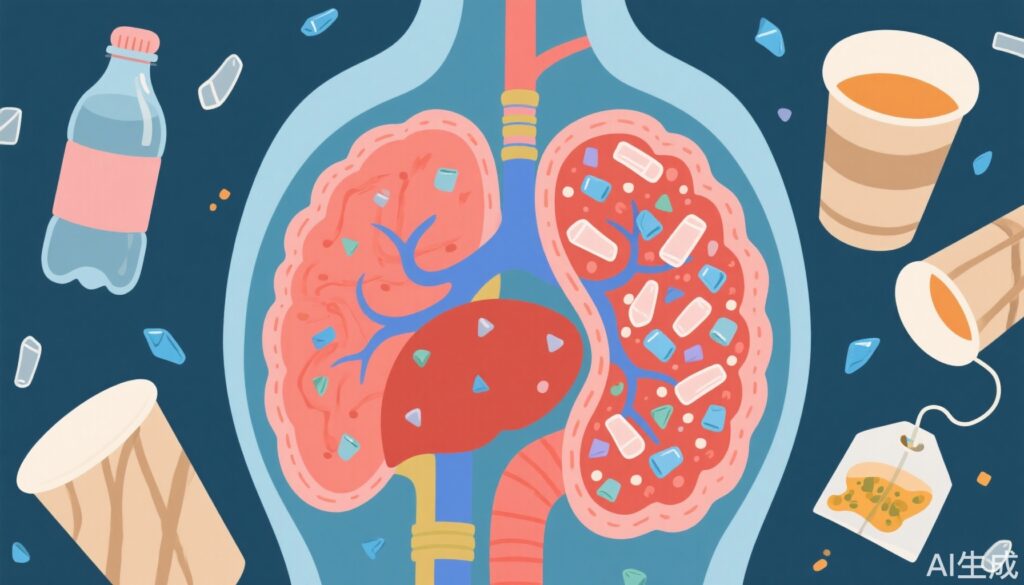Introduction: The Hidden Threat of Microplastics
Invisible to the naked eye but widespread in the environment, microplastics have become a new frontier in public health concerns. Since being named by scientists in 2004, these plastic fragments under 5 millimeters in diameter have been recognized not just as a marine pollutant but as pervasive contaminants infiltrating air, water, food, and even our bodies. Their chemical stability allows them to persist in nature for hundreds of years, posing significant risks to ecosystems and human health alike. This article explores how microplastics enter the human body, the potential damage they cause, hidden sources we might overlook, and steps we can take to reduce exposure.
Scientific Evidence: Microplastics Invading Our Cells and Organs
A groundbreaking 2024 study published in Scientific Reports revealed that microplastics accumulate rapidly in fat tissue. Within just 24 hours, these plastic particles infiltrate adipose-derived stem cells, promoting cellular aging and inflammation, while impairing their ability to differentiate into new fat cells. This discovery highlights a dual threat—accelerated biological aging and heightened inflammatory responses—which could undermine tissue function and overall health.2
Beyond fat cells, microplastics have been detected in multiple human organs including the brain, heart, lungs, intestines, liver, and even bone marrow. Comprehensive reviews show that exposure to microplastics adversely affects the reproductive, digestive, and respiratory systems, with potential links to cancers such as colon and lung cancer.3,4 Adding to these alarming findings, a 2024 study in The New England Journal of Medicine reported that patients with microplastics found in carotid artery plaques faced a 3.53-fold increased risk of cardiovascular events—including heart attacks and strokes—over 34 months of follow-up.5
These studies collectively paint a concerning picture: microplastics are not mere environmental debris but active, harmful invaders within the human body, capable of accelerating disease processes and impairing vital organ functions.
How Do Microplastics Enter Our Bodies?
Microplastics penetrate the human body through three main pathways:
1. Ingestion: Food and beverages are major sources. Bottled water, seafood (such as mussels and oysters), and seaweed often contain measurable microplastics. A 2024 study found that an average 1-liter bottled water contained around 240,000 microplastic particles, increasing when bottles are exposed to high temperatures.7
2. Inhalation: Indoor air can contain hundreds to thousands of microplastic particles per cubic meter; confined spaces such as cars have even higher concentrations. Adults can inhale approximately 70,000 microplastic particles daily from air alone.6
3. Dermal Absorption: Though less studied, plastic microbeads from cosmetics (e.g., exfoliating scrubs) and microplastics generated from the wear of cleaning sponges can breach the skin barrier, especially if the skin is damaged or inflamed.6
Five Hidden Sources of Microplastics in Daily Life
While plastic bags and containers are well-known culprits, numerous everyday items release microplastics, often unnoticed:
| Source | Key Findings |
|——————-|———————————————————————————————-|
| 1. Bottled Water | Contains ~240,000 microplastic particles per 1L; heat exposure increases release.7 |
| 2. Chewing Gum | Chewing gum releases thousands of microplastic particles within minutes; up to 94% after 8 minutes.8 |
| 3. Disposable Paper Cups | Hot beverages leaching ~25,000 microplastic particles into drinks in 15 minutes.9 |
| 4. Nylon Tea Bags | Brewing tea in nylon or polyester bags at 95°C for 5 minutes releases billions of micro- and nano-plastics.10 |
| 5. Cleaning Sponges| Each gram of worn sponge shed releases millions (6.5 million) of microplastic particles.11 |
These sources underscore how microplastics are embedded in products we use frequently, often without awareness.
Practical Strategies to Reduce Microplastic Exposure
To mitigate microplastic-related health risks, consider the following recommendations:
– Reduce Plastic Use: Replace single-use plastics with glass, ceramic, or stainless-steel alternatives.
– Choose Natural Toys: Opt for wooden or plastic-free toys, especially for children, to avoid ingestion of microplastics from biting or chewing.
– Minimize Plastic Packaging: Order food without disposable utensils, bring reusable containers for leftovers, and select unpackaged fresh produce.
– Boil Water Before Drinking: Heating water may reduce microplastic contamination.12
– Use Reusable Shopping Bags: Cloth bags or mesh nets help eliminate plastic bag waste.
– Avoid Heating Food in Plastic Containers: Higher temperatures increase microplastic release.
– Don’t Store Condiments in Plastic Bottles Long-Term: Avoid storing vinegar or soy sauce in plastic bottles over long durations to prevent leaching.13
– Choose Washable Cotton Towels Over Disposable Wipes: Many disposable wipes contain plastic fibers.
– Avoid Personal Care Products with Plastic Microbeads: Check labels to avoid exfoliating or cleansing products that release microplastics.
– Keep Indoor Air Clean: Regular vacuuming and wet mopping reduce dust-borne microplastic inhalation.
Case Illustration: Maria’s Story
Maria, a 35-year-old office worker living in a metropolitan area, often drinks bottled water, enjoys hot tea from nylon tea bags daily, and uses disposable paper cups at work for her coffee. Recently, Maria began experiencing unexplained fatigue and mild cognitive difficulties. Concerned about environmental toxins, she asked her physician about microplastic exposure risks. The doctor explained how daily habits could contribute to microplastic accumulation affecting multiple organs and encouraged Maria to switch to filtered tap water in glass bottles, use loose-leaf tea, and bring her own ceramic cup to work. Although the scientific understanding of direct causality is evolving, Maria appreciated actionable steps towards reducing her exposure and improving her health.
Expert Perspectives
Dr. Emily Chen, a toxicologist specializing in environmental health, notes, “Microplastics represent a new class of pollutants with complex biological interactions. Research indicates their ability to accelerate aging at a cellular level and promote inflammation. More research is urgently needed, but precautionary measures are wise and feasible.”
Environmental scientist Dr. Mark Lewis adds, “The infiltration of microplastics into human organs and cardiovascular plaques is a wake-up call. We must advocate for stronger regulation of plastic use and innovation in safer materials, alongside personal lifestyle changes.”
Conclusion: Addressing a Growing Public Health Challenge
Microplastics have silently but pervasively entered human bodies, accumulating in critical organs and impairing cellular functions. Evidence links microplastic exposure to accelerated cellular aging, inflammation, and increased risks of cancers and cardiovascular diseases. Hidden sources in daily life, such as bottled water, tea bags, and disposable cups, contribute significantly to exposure. Reducing plastic usage, adopting safer alternatives, and maintaining clean environments are practical and necessary steps. As research continues to unfold, awareness and proactive measures remain key to protecting public health from this invisible threat.
References
1. Guangdong CDC. “Beware! Microplastics Are Stealthily Invading, Know the Potential Hazards!” People’s Daily Health, July 8, 2025.
2. Li J, et al. “Microplastic exposure linked to accelerated aging and impaired adipogenesis in fat cells.” Scientific Reports. 2024;14:23920.
3. Wu W, et al. “The potential toxicity of microplastics on human health.” Science of the Total Environment. 2024;912:168946.
4. Zhao S, et al. “Effects of Microplastic Exposure on Human Digestive, Reproductive, and Respiratory Health: A Rapid Systematic Review.” Environmental Science & Technology. 2024;58(52):22843-22864.
5. Huang L, et al. “Microplastics and Nanoplastics in Atheromas and Cardiovascular Events.” New England Journal of Medicine. 2024;390(10):900-910.
6. Prata JC. “Airborne Microplastics: Consequences to Human Health?” Environmental Pollution. 2018;234:115-126.
7. Mason SA, et al. “Plastic contamination of bottled water.” Proceedings of the National Academy of Sciences (PNAS). 2024.
8. University of California, 2025 research report on chewing gum and microplastics.
9. Li D, et al. “Release of microplastics from disposable paper cups into hot drinks.” Journal of Hazardous Materials. 2020.
10. Hernandez LM, et al. “Plastic teabags release billions of microparticles and nanoparticles into tea.” Environmental Science & Technology. 2019;53(21):12300-12310.
11. Research from Environmental Science & Technology, 2024.
12. Liu S, et al. “Reducing microplastic exposure by boiling water.” Health Science Reports. 2023.
13. Study on microplastics leached from condiment bottles, 2024.



